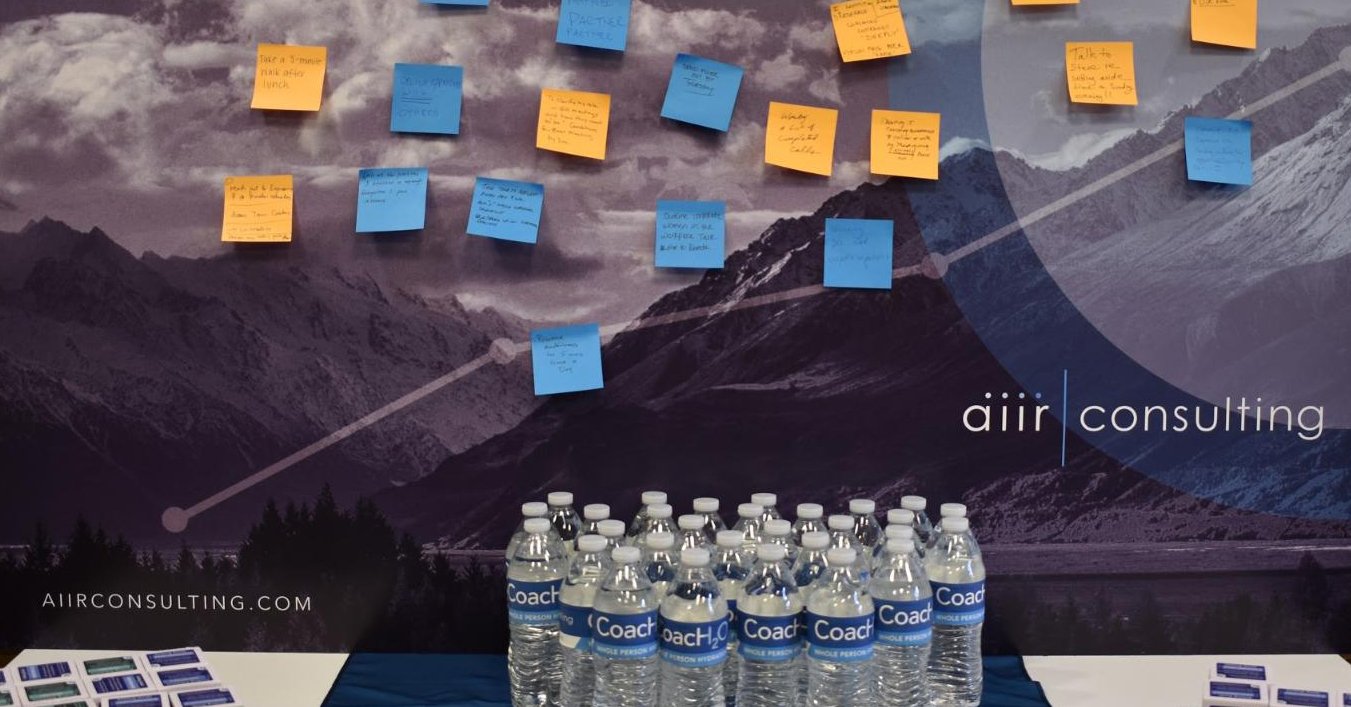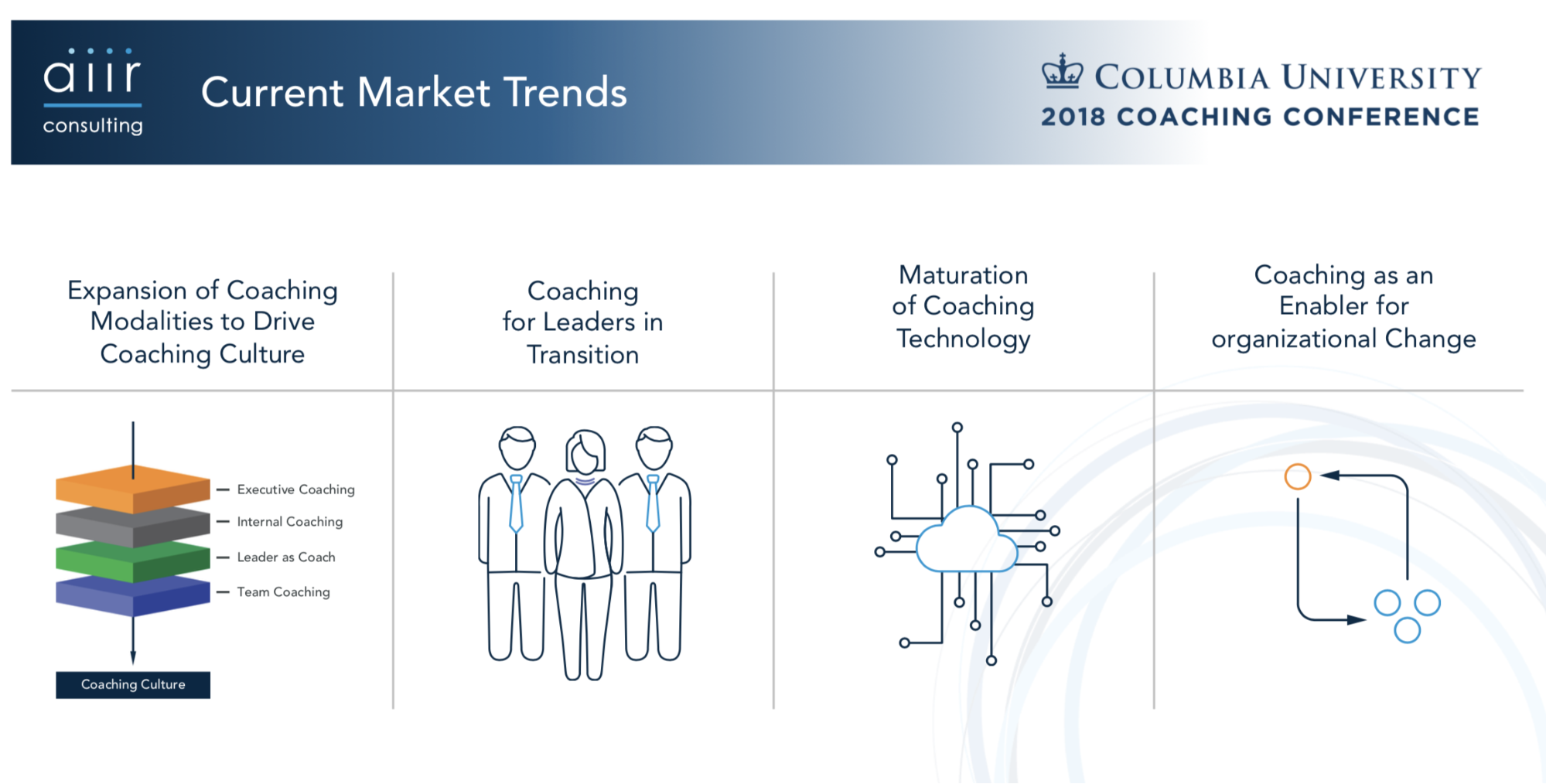
Our Top 5 Learns from the Columbia Coaching Conference
AIIR Consulting was proud to be a Platinum Sponsor of Columbia University’s Columbia Coaching Conference, which took place on October 17–19th in New York City. The Conference theme was Systemic Coaching: Whole Person | Whole Organization.
The theme of systemic coaching is extremely relevant for businesses today who need to go beyond the traditional view of coaching as an ad-hoc intervention for a lucky few senior leaders. For coaching to truly influence business results, it must be viewed through a systemic lens and how it adds value to a whole organization, not just a collection of individual coaching recipients
The success of any conference can be measured by the magnitude of learning, quality of connections. At AIIR, we would also add: fun! We can confidently check those three boxes and are eager to share our top five experiences and associated learning through our discussion below.
1. Focus and Emotional Intelligence

AIIR founder and CEO Jonathan Kirschner, Psy.D., introduces famed psychologist Daniel Goleman.
AIIR Consulting had the great privilege of introducing Daniel Goleman, the pre-eminent scholar of emotional intelligence and a pioneer in our field. Goleman shared his latest thinking on emotional intelligence and how the world has changed since his original model of emotional intelligence was proposed in the mid-90s.
According to Goleman, people receive 5X more information today than 20 years ago. While that input can be harnessed and leveraged to achieve great things, it can also dramatically impoverish people’s attention spans.
As such, our big takeaway from Goleman was that, given the complex networks in which we operate and the number of inputs we process daily, mindfulness is essential for staying focused. Goleman prefers to think of this as “Cognitive Control” which is akin to mental fitness. In a state of cognitive control, we are primed for learning because our mind is both calm and clear.
2. Coaching conversations at the Core of organizational health

Figure 1
At the closing session on Day 1, Dr. Sean O’ Connor from the University of Sydney discussed the immense power of networks and network effects in his presentation: The Coaching Ripple Effect. Our key learn here was just how core a coaching conversation can be to the overall organizational network:
- If the quality of our conversations guide the durability and quality of our relationships,
- And the strength of our relationships determines the net health of the system, or the organization we exist within, then…
- Our day-to-day conversations and interactions are at the root of our organizational health.
Figure 1 provides a stunning example of Dr. O’ Connor’s research on how coaching impacts the organizational system.
3. Scaling Coaching Panel
AIIR Consulting had the privilege of hosting five industry leaders for an exciting panel discussion on the topic of systemic coaching in practice. The panel combined the perspectives of:
- Martin Scott | VP of Leadership Acceleration, Comcast
- Dr. Nandi Shareef | People Development, Uber
- Erica Barnes | Director of Talent Management, Anthem
- Christine Vaccola | Head of Global Talent Programs, Sanofi
- Dr. Niloofar Ghods | Cisco, Senior Manager of Leadership and Team Intelligence

Dr. Geetu Bharwaney (standing) leads an all-star panel of (from left to right): Martin Scott (Comcast), Dr. Nandi Shareef (Uber), Erica Barnes (Anthem), Christine Vaccola (Sanofi) and Dr. Niloofar Ghods (Cisco) at the Columbia Coaching Conference.
Moderated by Dr. Geetu Bharwaney, one of AIIR’s senior-level executive coaches, the panel tackled the key business drivers of coaching, how business context influences the coaching strategy, and the variety of ways coaching can be implemented beyond traditional 1-1 executive coaching. Our biggest learns derive from how these 5 leaders are uniquely scaling coaching within their respective enterprises.
First, it is apparent that a great deal of strategy goes into designing a coaching program that can scale. At the outset, HR professionals must consider what they want coaching to achieve. What are the key organizational outcomes that their coaching program will target? Knowing where to start involves critically examining your leadership needs and then determining how coaching can be uniquely implemented to address them. At this phase, it’s crucial to determine how results will be measured. Doing so ensures the coaching is aligned with the business strategy. It also builds in sustainability for the program. If coaching impact and ROI can be measured and shared, this will naturally lead to future interest in growing the coaching strategy.
The next challenge is building the business case for buy-in. Coaching at scale requires substantial resources and support. How will you sell your vision not only to key stakeholders but to the recipients of coaching themselves?
We also learned that scalable, systemic coaching requires a multi-modal approach. With external coaches, internal coaches, and managers using coaching skills, HR leaders have a variety of options at their disposal to scale coaching. Organizations can use these formats in concert to strengthen the development of employees at all stages of leadership.
Specific Insights from the Panel:
- Scaling coaching requires a strategy that takes into account the principles of selling, change management, and strong stakeholder relationships.
- A good coaching strategy has numerous coaching applications that are addressing different needs in the organization.
- It is vital to establish a clear way to measure effectiveness, or else the spend cannot be justified.
- To scale coaching over a multi-year journey, it’s vital to have a coach management technology to see, track, and manage coaching engagements.
- Coaching can be applied in a differentiated way at each level of an employee’s career path.
- The criteria used to determine whether a coaching need is best met through an internal coach or an external coach.
- A coaching culture can yield tools for becoming more reflective, achieve managerial maturation, and teach leaders to slow down in order to speed up.
We thank Martin, Nandi, Erica, Christine, and Niloofar for bringing their cutting-edge thought leadership to the Columbia Conference.
4. Coaching can be done in 15 minutes!

A participant and senior AIIR Coach during conduct a Rapid Coaching session.
At AIIR, we use our four-stage process, the AIIR® Method, to create sustained behavior change (Assessment – Insight – Implementation – Reinforcement). The typical AIIR engagement is 6 months in duration. At the Columbia Conference, we did it in 15 minutes! For the first time ever, we experimented with a warp-speed version of the AIIR® Method to achieve each of the 4 stages of the AIIR® Method within a 15-minute time span.

The Commitment Board in the AIIR Rapid Coaching Room at the Columbia Coaching Conference.
Conference attendees who opted in were paired with a Senior Level AIIR Consultant. In the Assessment Phase, coach and coachee (conference participant) identified a single area that the coachee would like to focus on. Next, they moved to the Insight Phase. Here, the coachee worked to expand his/her collective understanding of some of the underlying causes and contributing factors related to the selected focus area. The coach and coachee then moved to the Implementation Phase where they identified 1-2 concrete, actionable steps the coachee was willing to commit to taking in order to make meaningful change in their coaching area. The coachee was asked to record a single commitment on a post-it note and then stick it on the Commitment Board. In the final phase, Reinforcement, the coach and coachee brainstormed strategies for ensuring the new behavior is sustained for the long term.
In 2 days, we had 21 Rapid Coaching sessions (approximately 315 coaching minutes) and a few more than 21 amazing commitments that each coachee posted to our shared Commitment wall for support and accountability.
5. Coaching Trends

Market trends identified during a panel discussion featuring leaders from JP Morgan, S&P, Saudi Aramco, the Churchill Group, and AIIR Consulting.
On the final day of the conference, Dr. Terrence Maltbia, Director of the Columbia Coaching Program, moderated a panel with leaders from JP Morgan, S&P, Saudi Aramco, the Churchill Group, and AIIR Consulting. The panelists shared how they are utilizing coaching in their respective organizations as well as where coaching is trending toward. Key trends include:
1. Expansion of Modalities to Drive Coaching Culture
Whereas companies once relied on traditional executive coaching to address the enterprise needs, they are now utilizing multiple types of coaching modalities (leader as coach, internal coaching, team coaching, and executive coaching). And, whereas the goal may once have been accelerating performance for senior leaders, coaching is increasingly seen as an opportunity throughout the enterprise, independent of level. These organizations are seeking to build coaching cultures.
2. Coaching for Leaders in Transition
Leaders transitioning into new roles face innumerable obstacles. Ascending to the next level of organizational leadership requires adopting skills that were not needed for their previous roles, therefore immediately pushing transitioning leaders out of their comfort zones. When coaching is provided to leaders transitioning into roles with greater demands and responsibility, it acts as a catalyst to help them achieve a successful transition. Increasingly, organizations are looking to get ahead of the curve by providing coaching in this context, proactively through a programmatic approach, rather than reactively, through an ad-hoc approach.
3. Maturation of Coaching Technology
At the conference, there was a clear theme around scaling coaching across the enterprise. Among the organizations truly scaling coaching, the utilization of coaching technology seems essential. Whether a coach management system for tracking information on the HR side or video-conferencing to deliver seamless, near face-to-face meeting, the integration of coaching and technology is reaching a new level of adoption and seen as essential to long-term scaling success.
4. Coaching as an Enabler for Organizational Change
The incessant change amidst large organizations today is undeniable. 10 years ago, a re-organization or significant change was seen as a one-time event. Today, and increasingly tomorrow, massive change will continue at greater frequency and magnitude. Rather than waiting for leaders to risk burnout or derail, organizations are proactively investing in the leaders who are at the epicenter of change initiatives in order to bolster their effectiveness, and subsequently, the leaders’ respective team performance.
About AIIR
Started in 2010, AIIR Consulting is a global leadership development firm dedicated to increasing the effectiveness and performance of leaders, teams, and organizations. Through the strategic integration of coaching and technology, AIIR Consulting designs and delivers solutions that create exceptional value, as well as measurable results for our clients’ leadership organizational system – Individuals, Teams, and the Organization’s Leadership Pipeline. To learn more about how you can get some AIIR, reach out at [email protected].
Are You Ready To Shape A Better Future Together?
Partner with AIIR to empower your leaders and ascend into the future.